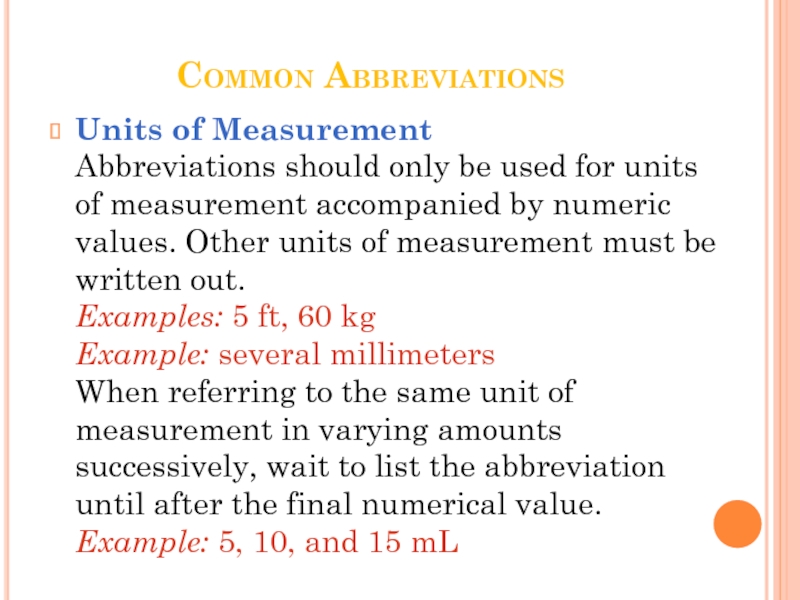- Главная
- Разное
- Образование
- Спорт
- Естествознание
- Природоведение
- Религиоведение
- Французский язык
- Черчение
- Английский язык
- Астрономия
- Алгебра
- Биология
- География
- Геометрия
- Детские презентации
- Информатика
- История
- Литература
- Математика
- Музыка
- МХК
- Немецкий язык
- ОБЖ
- Обществознание
- Окружающий мир
- Педагогика
- Русский язык
- Технология
- Физика
- Философия
- Химия
- Шаблоны, фоны, картинки для презентаций
- Экология
- Экономика
Презентация, доклад на тему Abbreviations
Содержание
- 1. Abbreviations
- 2. An ABBREVIATION is a contracted or shortened
- 3. Types of AbbreviationsAbbreviations that can be pronounced
- 4. General Rules for Abbreviating First UseIf an abbreviation
- 5. Punctuation and AbbreviationsPeriods While shortened versions of
- 6. Punctuation and AbbreviationsOther Punctuation If you end
- 7. Punctuation and AbbreviationsPlurals of Abbreviations Simply add
- 8. Common AbbreviationsMany abbreviations are commonly understood and
- 9. Common AbbreviationsPlaces Only abbreviate states when used
- 10. Common AbbreviationsUnits of Measurement Abbreviations should only
- 11. Common AbbreviationsBibliographical Terms Abbreviations for words such
- 12. Latin AbbreviationsUse Latin abbreviations in source citations
An ABBREVIATION is a contracted or shortened form of a word.Many abbreviations are just shortened versions of words. Example: October => Oct.
Слайд 2An ABBREVIATION is a contracted or shortened form of a word.
Many
abbreviations are just shortened versions of words.
Example: October => Oct.
Слайд 3Types of Abbreviations
Abbreviations that can be pronounced as words are called
acronyms.
Example: NASA (National Aeronautics and Space Administration), OPEC (Oil Producing Economic Countries)
Initialisms are abbreviations that cannot be pronounced as words. Each letter in an initialism is pronounced.
Example: NRA (National Rifle Association), BBC (British Broadcasting Company)
Слайд 4General Rules for Abbreviating
First Use
If an abbreviation is unfamiliar to your
readers, spell out the full term the first time you use it and give the abbreviation in parentheses.
Example: intensive care unit (ICU)
Only use an abbreviation if it has been established earlier in the document.
Best Practice
Only use an abbreviation when it saves space and avoids tedious repetition. According to APA, if the abbreviation appears fewer than three times, spell the term out instead.
Only use an abbreviation when it saves space and avoids tedious repetition. According to APA, if the abbreviation appears fewer than three times, spell the term out instead.
Слайд 5Punctuation and Abbreviations
Periods
While shortened versions of words are usually followed by
a period, there are no definitive rules that govern whether you should put periods after each letter in an initialism or acronym. Check your
discipline’s style guide.
Examples: F.B.I., FBI
Note: UMB’s print style guide does not use periods with initialisms or acronyms.
If you use an abbreviation at the end of the sentence, do not use an additional period.
Example: Sarah applied to the F.B.I.
Слайд 6Punctuation and Abbreviations
Other Punctuation
If you end a question or an exclamation
with an abbreviation, include both the final period as well as the question mark or exclamation point.
Example: Did Sarah apply to the C.I.A.?
This same rule applies to commas.
Example: After Sarah applied to the C.I.A., did she apply to the F.B.I.?
Слайд 7Punctuation and Abbreviations
Plurals of Abbreviations
Simply add an “s” to form the
plural of most abbreviations.
Example: vols.
Units of measurement are an exception to this rule.
Incorrect: 12 kms
Correct: 12 km
Слайд 8Common Abbreviations
Many abbreviations are commonly understood and do not need to
be spelled out in your document.
Dates and Times
Abbreviate months only when used with a specific date. Do not abbreviate them when used with just a year.
With Specific Date: Aug. 28, 1989
With Year: August 1989
Слайд 9Common Abbreviations
Places
Only abbreviate states when used with the name of a
city, town, or county.
Correct: Baltimore, MD
Incorrect: MD
In formal writing, the United States should only be abbreviated when being used as an adjective.
Correct: I hope the U.S. figure skating team will win the Olympics.
Incorrect for Formal Writing: I live in the U.S.
When referencing other countries, spell out the full name of the country the first time it is mentioned. If a
well-known abbreviation for the country exists, it can be used subsequently.
Example: Democratic Republic of Congo => DCR
Слайд 10Common Abbreviations
Units of Measurement
Abbreviations should only be used for units of
measurement accompanied by numeric values. Other units of measurement must be written out.
Examples: 5 ft, 60 kg
Example: several millimeters
When referring to the same unit of measurement in varying amounts successively, wait to list the abbreviation until after the final numerical value.
Example: 5, 10, and 15 mL
Слайд 11Common Abbreviations
Bibliographical Terms
Abbreviations for words such as “edition” and “page” are
frequently used in source citations. However, these abbreviations are generally not used in body text.
Incorrect: The sixth ed. of Lippincott’s book has more diagrams than the Course Atlas.
Correct: The sixth edition of Lippincott’s book has more diagrams than the Course Atlas.
Слайд 12Latin Abbreviations
Use Latin abbreviations in source citations and parenthetical comments. Avoid
using them in your body.
Examples: i.e. = that is, e.g. = for example, etc. = and other things
Examples: i.e. = that is, e.g. = for example, etc. = and other things

















